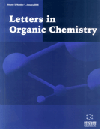- Home
- A-Z Publications
- Letters in Organic Chemistry
- Previous Issues
- Volume 17, Issue 9, 2020
Letters in Organic Chemistry - Volume 17, Issue 9, 2020
Volume 17, Issue 9, 2020
-
-
A Rationale for the Ortho Effect in Electrophilic Aromatic Substitutions
More LessAuthors: Timothy Eckert, Grace Harmeyer, Steven Legate and Steven MatheThe ortho effect arises in certain electrophilic aromatic substitutions when a meta director is meta to an ortho/para director. Among the three expected isomer products, only the two isomers ortho to the meta director are produced normally. To find an explanation for the ortho effect, nitrations of two properly substituted benzenes were explored. Evidence supported an explanation based on resonance involving the meta director.
-
-
-
Thiazolidine-2, 4-Diones as Non-Hepatotoxic Tri-action Drug Candidates: Design, Synthesis, Characterization, Biological Evaluation and Docking Studies
More LessAuthors: Karuna S. Shukla, Shailendra Pandey and Pooja A. ChawlaThiazolidine-2, 4-diones and their derivatives are a well-established chemical class of compounds that express their pharmacological actions through insulin sensitization and enhanced glucose utilization in peripheral tissues. In the current research different approaches have been employed to synthesize thiazolidine-2, 4-dione derivatives and these synthesized compounds were chemically characterized for the esta Read More
-
-
-
Cytotoxic Prenyl and Geranyl Coumarins from the Stem Bark of Casimiroa edulis
More LessAuthors: Khun N. W. Tun, Nanik S. Aminah, Alfinda Novi Kristanti, Rico Ramadhan and Yoshiaki TakayaPhytochemical investigation of the methanolic extract of the stem bark of Casimiroa edulis afforded four coumarins. Various spectroscopic experiments were used to characterize the isolated coumarins. The structures were identified as auraptene (K-1), suberosin (K-2), 5-geranyloxypsoralen (bergamottin) (K-3), and 8-geranyloxypsoralen (K-4), based on the chemical and spectral analysis. Among these co Read More
-
-
-
Synthesis, Photophysics and Theoretical Calculation of (E)-2-(benzo[d] thiazol-2-yl)-3-(3-methoxyphenyl)acrylonitrile
More LessAuthors: Pei-Chieh Wu and Chih-Hsien ChenIn this study, a new type of luminogen with aggregation-induced-emission (AIE) behavior was designed and synthesized. The result of single-crystal X-ray structure showed a planar structure in which the dihedral angle between two aromatic rings is less than 30o. Moreover, two different intermolecular hydrogen bond interactions supported the stability of the crystal structure. After the formation of organic nanoparticles i Read More
-
-
-
MoO3 Nanoparticles as an Efficient Catalyst for the Synthesis of Pyrazoles in Aqueous-alcoholic Medium at Room Temperature
More LessAuthors: Sonatai Patil, Ananda Mane and Savita Dhongade-DesaiWe have successfully explored the potential MoO3 nanoparticles as a heterogeneous catalyst for the cyclocondensation of hydrazines/hydrazides with 1,3-dicarbonyl compound in aqueousalcoholic medium at room temperature. The present method has been developed using green chemistry measures and offers a range of N-substituted pyrazoles with moderate to excellent yields. Utilization of non-toxic catalyst, wide substrat Read More
-
-
-
A Novel Copper-Catalyzed Synthesis of N-Monosubstituted 2-Alkynimidamides from 1-Alkynes and Trichloroacetamidines
More LessA one-pot Cu-catalyzed synthesis of functionalized alkynyl imidamide by terminal alkynes, trichloroacetonitrile and aniline or benzyl amine is reported. The compounds were produced via coupling reaction of terminal alkynes with trichloroacetamidine. This method was performed under mild, ligand-free conditions and easy work-up method.
-
-
-
PEG1000 as a Low Melting and Ecofriendly Solvent for Air Oxidative and Catalyst Free 2,4-Disubstitute Quinazoline Synthesis
More LessAuthors: Ebrahim S. Moghadam, Shahrzad Ghafary and Mohsen AminiWith regard to the importance of quinazoline as a privileged scaffold, herein we report the synthesis of twenty seven 2,4-disubstitute quinazoline derivatives in a new catalyst free condition. In the current work, poly ethylene glycol (PEG1000) as an inexpensive, very simple commercially available, ecofriendly and low melting point solvent was used. Air bubbling, a green oxidant, for oxidation purpose was also used. This is Read More
-
-
-
Asymmetric Reactions in Water Catalyzed by L-Proline Tethered on Thermoresponsive Ionic Copolymers
More LessL-Proline was covalently tethered on thermoresponsive ionic block copolymers that formed micelles in aqueous solutions. The block copolymers consisted of a poly(N-isopropylacrylamide) (PNIPAAm) segment and an anionic or cationic polymer segment. These copolymers exhibited lower critical solution temperature (LCST) behavior at ca. 35-40°C, and achieved thermal stimuli-induced formation and dissociation of micelle Read More
-
-
-
Trifunctionalized Allenes. Part IV. Cyclization Reactions of 4-Phosphorylated 5-Hydroxyhexa-2,3-dienoates
More LessAuthors: Ismail E. Ismailov, Ivaylo K. Ivanov and Valerij Ch. ChristovThis manuscript focuses on the reactions of 4-phosphorylated 5-hydroxyhexa-2,3-dienoates with protected or unprotected hydroxy groups involving 5-endo-trig cyclizations. Reactions with electrophiles result in mixtures of the 2,5-dihydro-1,2-oxaphosphole-5-carboxylates and the 5-phosphorylfuran- 2(5H)-ones by competitive electrophilic cyclization due to the neighboring phosphonate (phosphine oxide) and the carb Read More
-
Volumes & issues
-
Volume 22 (2025)
-
Volume 21 (2024)
-
Volume 20 (2023)
-
Volume 19 (2022)
-
Volume 18 (2021)
-
Volume 17 (2020)
-
Volume 16 (2019)
-
Volume 15 (2018)
-
Volume 14 (2017)
-
Volume 13 (2016)
-
Volume 12 (2015)
-
Volume 11 (2014)
-
Volume 10 (2013)
-
Volume 9 (2012)
-
Volume 8 (2011)
-
Volume 7 (2010)
-
Volume 6 (2009)
-
Volume 5 (2008)
-
Volume 4 (2007)
-
Volume 3 (2006)
-
Volume 2 (2005)
-
Volume 1 (2004)
Most Read This Month
Article
content/journals/loc
Journal
10
5
false
en


